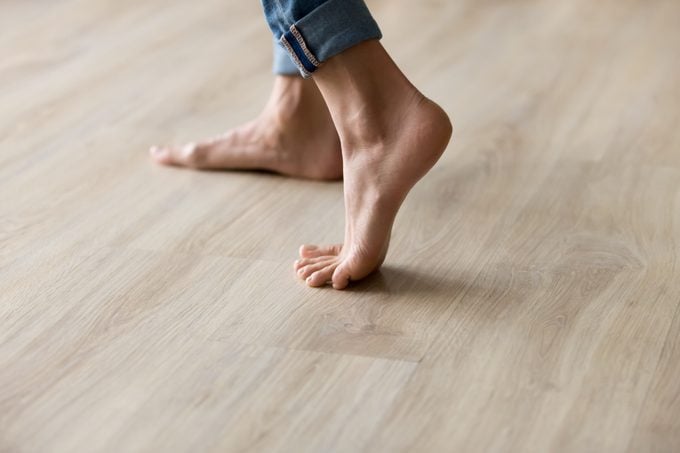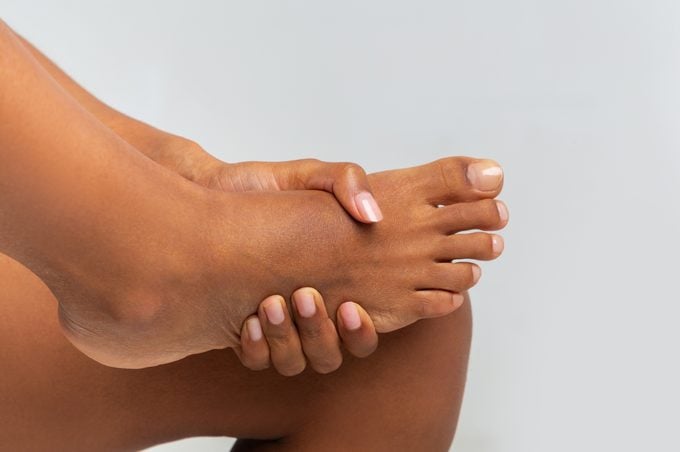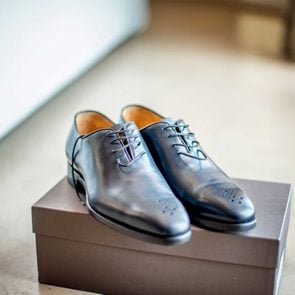Why Does the Top of My Foot Hurt?
Updated: May 03, 2021
When your feet hurt, every step becomes agony. Figure out what's causing your top of foot pain—whether it's an injury or an underlying disease.
What is that pain on the top of your foot?
That’s not an easy question to answer, given how surprisingly complex your feet are. Each one is made up of 26 bones, 30 joints, and more than 100 muscles, tendons, and ligaments. That can make it hard to pinpoint exactly what’s causing pain in your foot.
Pain in the top of the foot could be a sign of a handful of different issues, all of which are more or less likely depending on your age, level of activity, and other key features. For example, if you’re young and very active, foot pain is probably more likely to be a sign of a stress fracture or tendonitis. If you’re middle-aged or older and maybe not training for 10Ks, there’s probably more of a chance your pain is coming from a health condition like arthritis.
Taking a look at your lifestyle and other aspects of your health can help give you a better idea of what might be making your feet ache. (These foot symptoms can reveal signs of disease.)
Foot pain can also be due to an injury, like a break or sprain. If you drop something on your foot, trip, or fall, and your foot pain starts after that, there’s obviously a good chance that the incident had something to do with it.
Some of the common causes of mild pain in the top of the foot can usually be treated at home with some simple things like over-the-counter pain relievers and a good pair of shoes. But some might require a little more medical intervention—and most importantly, a proper diagnosis and treatment of the underlying issue.
It’s worth figuring out what’s going on and seek medical help if the pain doesn’t improve or starts to interfere with your daily life. Your feet are, after all, pretty important tools for taking you where you want to go. Taking good care of them and addressing any issues before they become bigger problems will help keep your feet healthy and functioning well for years to come.
Here are the most common causes of pain in the top of the foot, how it’s diagnosed, and treatment and prevention strategies to keep them safe and healthy.
Causes of pain on top of your foot
 Arthritis
Arthritis
Zachary Flynn, DPM, a podiatrist and fellowship-trained foot and ankle surgeon at Phoenix Spine & Joint in Arizona, says that osteoarthritis, or bone spurs as a result of arthritis, are the most common causes of top of foot pain. Arthritis pain usually feels like a deep ache or dull throbbing sensation in the affected joint that comes and goes at certain times. “Normally, it’s going to be painful when you first get out of bed in the morning, then slowly warm up or loosen up and be fine for four to six hours, and then start to ache again in the afternoon and at bedtime,” Dr. Flynn explains.
Pain from bone spurs (bony growths that can form as a result of arthritis) will usually hurt if your shoes are too tight or something else is pressing against the spur.
The risk of getting osteoarthritis increases with age, says Brian Burgess, DPM, board-certified podiatric surgeon at Illinois Bone & Joint Institute. Women are more likely than men to develop most types of arthritis, and a past injury to a joint can also increase your risk of developing arthritis in it (even at a younger age). Inflammatory arthritis, like rheumatoid arthritis or psoriatic arthritis, can also cause foot pain, and is more common in women as well.
 Peripheral neuropathy
Peripheral neuropathy
Peripheral nerves are all the nerves that exist in the body outside of the brain and spinal cord. This includes the nerves that are in the feet. When something interrupts the signals being sent on a specific nerve, it can cause uncomfortable symptoms like pain, numbness, burning, tingling, weakness, or sensitivity to touch.
Depending on which peripheral nerve is damaged and to what extent, symptoms can develop quickly or over the course of months or even years.
The National Institutes of Health estimates that more than 20 million people in the United States have some form of peripheral neuropathy. However, it’s not frequently tested for and is often misdiagnosed, so that number is quite likely higher. Sometimes, neuropathy can happen without an apparent cause. Other times, it’s the result of an injury—from something traumatic like a fall or crash, a medical procedure, or a sports injury that damages the nerve—or a disease.
Diabetes is the No. 1 cause of peripheral neuropathy in the United States. In fact, around 60 to 70 percent of people with diabetes have some form of nerve damage. Chronically high blood sugar damages your nerves over time, and usually, diabetes-related neuropathy starts in the feet. (Here are the best shoes for neuropathy.)
Smoking, high blood pressure, kidney and liver disorders, autoimmune diseases, nutritional imbalances, and certain cancers and infections can also lead to neuropathy.
(Here are some natural remedies for peripheral neuropathy.)
Stress fracture
A stress fracture is a small crack or severe bruising of a bone, which is most often caused by overuse. Unlike arthritis, a stress fracture will probably hurt consistently throughout the day, and feel even worse the more pressure you put on it, he adds.
Runners and other overzealous exercises are the most at risk for stress fractures in the foot, Dr. Flynn says. So, they’re usually experienced by a younger crowd than the arthritis bunch. There’s also a strong correlation between stress fractures and vitamin D deficiency, Dr. Burgess says. And many people in the United States are deficient in this important bone-building nutrient.
Tendinitis
Tendinitis is inflammation of a tendon, the thick tissues that connect muscles to bone. Insertional extensor tendonitis is tendinitis in the tendons on the top of the foot that connect to the toes and let you pull them up, Dr. Flynn says. “The pain is going to be a little sharper, kind of an ache or sometimes a throb, and you will feel it when you start to engage or load the tendon,” he explains.
Tendinitis usually does not hurt when you’re just sitting there not using the affected tendon. The pain will also be closer to the surface than a stress fracture would, and you may notice some swelling.
Tendinitis is known as an overuse injury and often happens as a result of too much repetitive physical activity, or doing physical activity with improper form or unsupportive footwear. “It’s common in patients running or hiking and being more active on uneven terrain—the tendons are firing more on uneven terrain than if you were on flat ground,” Dr. Flynn says. People with “flat feet” and those with arthritis are also more prone to tendinitis.
Peroneal nerve irritation
Pain that can be described as numbness, tingling, or burning is traditionally a sign of nerve irritation, Dr. Flynn says. The peroneal nerve (a branch of the sciatic nerve) runs pretty much right down the middle of the top of the foot, he explains. “The top layer is skin, beneath is a tendon, and then directly beneath that is the nerve,” he says.
If your shoe is too tight, it can press on the top of the nerve and cause irritation. This is more common in people who have bone spurs from arthritis, Dr. Burgess says.
If this nerve irritation is also present in your butt or down your leg, it could be a sign of sciatica, Dr. Flynn says. Sciatica is pain caused by pinching or compression of the sciatic nerve in the lower back. Since the nerve runs down the side of the butt, leg, and into the top of the foot, a back issue impacting the sciatic nerve can cause top-of-foot pain, though it’s not likely you’d feel it in your foot without also feeling it in your butt or leg.
Gout
Gout is a type of inflammatory arthritis that typically causes one joint—most commonly, the big toe—to become inflamed and painful. The pain is usually intense and accompanied by swelling, redness, and a hot sensation. Flares usually start suddenly, coming on fast and fierce, and can last for days or weeks. (Learn what else can cause toe pain.)
Gout is caused by elevated levels of uric acid in the body, a condition called hyperuricemia. Too much uric acid can cause uric acid crystals to build up in the joints and tissues.
A few things can increase your risk of developing gout. It’s one type of arthritis that’s actually more common in men. Being obese, having certain health conditions, including congestive heart failure, hypertension, metabolic syndrome, insulin resistance, and diabetes can make you more likely to develop hyperuricemia and ultimately gout. Other factors include taking diuretics, eating or drinking things high in fructose, and a diet high in purines (found in red meat, organ meat, and some kinds of seafood), which break down into uric acid and can lead to gout.
(Is it gout or a bunion? Here’s how to tell.)
How doctors diagnose top of foot pain
Foot doctors do a few things to diagnose the source of top of foot pain. First, they’ll ask you some questions about your medical history and do a physical exam, Dr. Burgess says. Knowing the nature of the pain (Is it sharp or dull? What activities make it worse?) and the location will help your doctor narrow down the potential causes. Then, they’ll probably do an X-ray.
“More likely than not, X-ray is needed to confirm the diagnosis,” Dr. Burgess says. “We can make an assumption and sometimes treat based on that assumption, and if the physician feels an X-ray may not change the course of treatment they may not order one,” he adds. But it’s usually the best way to know what’s actually going on—especially since it can be hard to decipher one potential top of foot pain cause over another.
Stress fractures can sometimes be the hardest cause to accurately diagnose, Dr. Burgess says. “A lot of times, X-rays are negative initially—it’s not until the body starts to heal and lay down bone callus that you start to see radiographic changes,” he explains. If your symptoms sound like a stress fracture but an X-ray comes back negative, your doctor may send you for an MRI, which could pick it up. Or, they may just treat it as a suspected stress fracture, Dr. Burgess says.
Treatment options for foot pain
Most of these issues can be treated very similarly, at least at first. The general recommendation is to first try self-treatment, Dr. Burgess says. Taking over-the-counter non-steroidal anti-inflammatory (NSAIDs) medication like ibuprofen or naproxen, avoiding activities that make the pain feel worse, icing, and switching to more supportive shoes, are all first-line treatments for top of foot pain, no matter the cause.
Physical therapy for arthritis
If you have arthritis, and the pain is interfering with your ability to do the activities you want to do, your doctor may also refer you to a physical therapist who can teach you some exercises to help alleviate some of the pain and discomfort. You’ll also want to work with your doctor to figure out ways to reduce arthritis triggers and the frequency of flares.
Changing lifestyle habits for nerve damage or irritation
If nerve damage or irritation is causing your foot pain, your doctor will need to treat the root cause—so, not just the nerve problem, but whatever is causing the nerve problem, if possible. That may involve changing your lifestyle habits or activities, in addition to more invasive medical procedures (like fixing the back problem that’s giving you sciatica) depending on how debilitating the pain is.
Stretching exercises for tendinitis
Certain stretching exercises can also help tendinitis, so your foot doctor may suggest some for you to try at home, Dr. Burgess says. If they don’t seem to help, they may refer you to formal physical therapy.
Wearing supportive devices for stress fracture
Stress fracture treatment may also include wearing a supportive device like a boot or surgical shoe that reduces the weight you put on the fractured bone, Dr. Burgess says.
NSAIDs for gout pain
Gout pain can be managed with NSAIDs and the anti-inflammatory drug colchicine. Healthy lifestyle changes like limiting alcohol, eating fewer purine-rich foods, losing weight, and changing medications can all help reduce the occurrence of future flares. Talk with your care provider about what might help you.
(Get relief with these gout natural remedies.)
Prevention for top of foot pain
Tendonitis and stress fractures are both typically caused by overuse. To avoid them, always ramp up a new exercise routine slowly, Dr. Flynn says. Give your body time to adapt to the new stresses you’re putting on it, so that it can get stronger and be ready for more stress. If you do too much too soon and don’t work up slowly, you’re in a good position to get hit with an overuse injury.
Also, wearing supportive footwear can help reduce the risk of foot pain from all causes. Dr. Burgess says he sees a wave of foot pain in early summer when people are switching from shoes to flip-flops. Good, supportive shoes will absorb some of the shock that goes up through the foot when you make contact with the ground, but flip-flops have none of this support. “Something with a stiffer sole that doesn’t bend as easy is a better option than a cheap rubber flip-flop,” Dr. Burgess says.
The best shoes are those with cushioning and arch support that protect your feet when you walk or exercise. Making sure they fit well is key, too. (These are the best flip-flops with arch support.)
The bottom line
While at-home treatments can help improve many types of foot pain, it’s important to find out what exactly is causing your discomfort so that it can be fixed properly. Make an appointment with your doctor if your foot pain gets worse or doesn’t improve after taking NSAIDs, resting, and wearing good footwear. Even if the pain is brand new, if it’s severe and interfering with your life, that’s a sign you need medical attention.
It’s always better to fix the problem sooner rather than later so you can avoid any additional complications and get back to doing the things you love.
Next, here’s what podiatrists won’t tell you.























